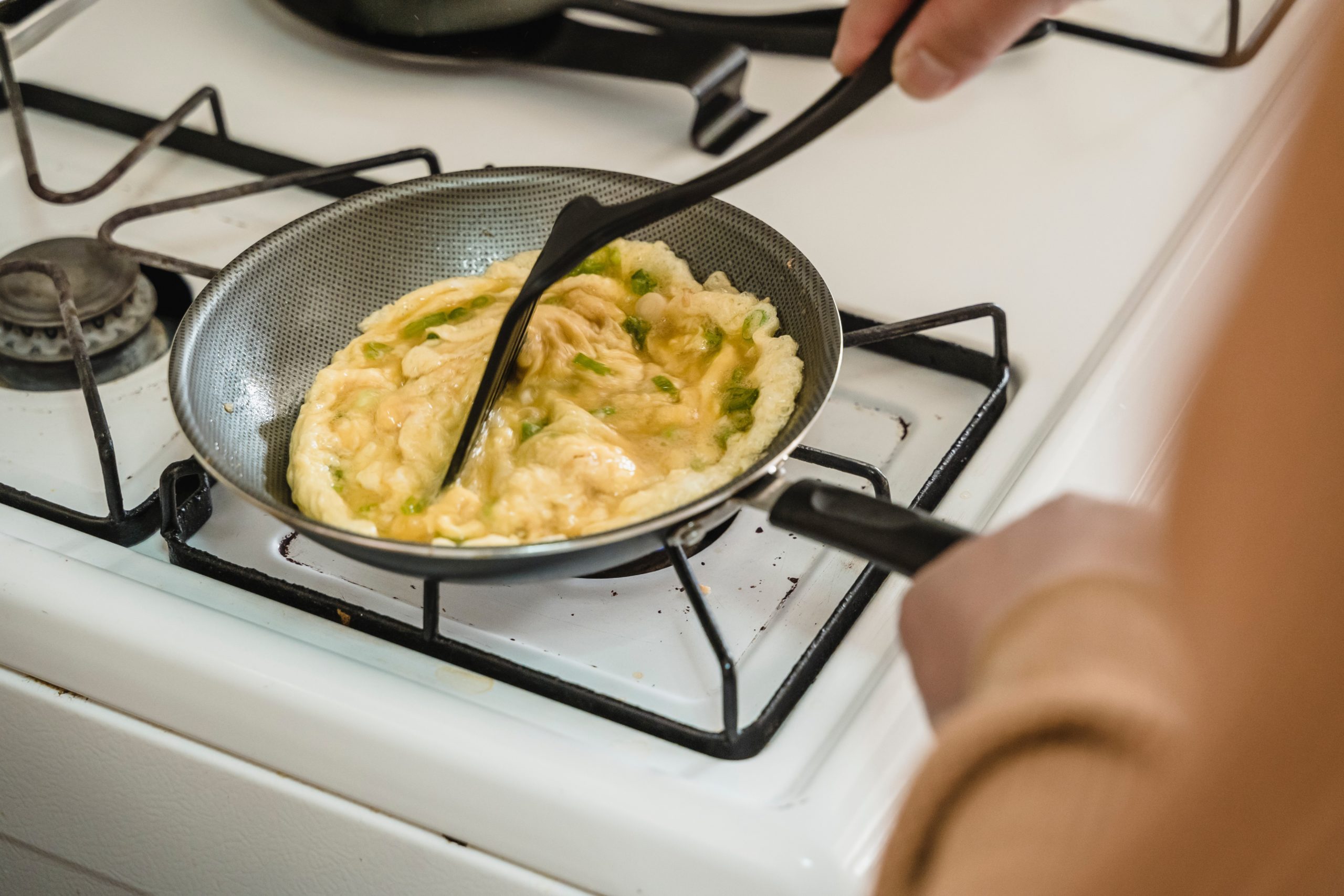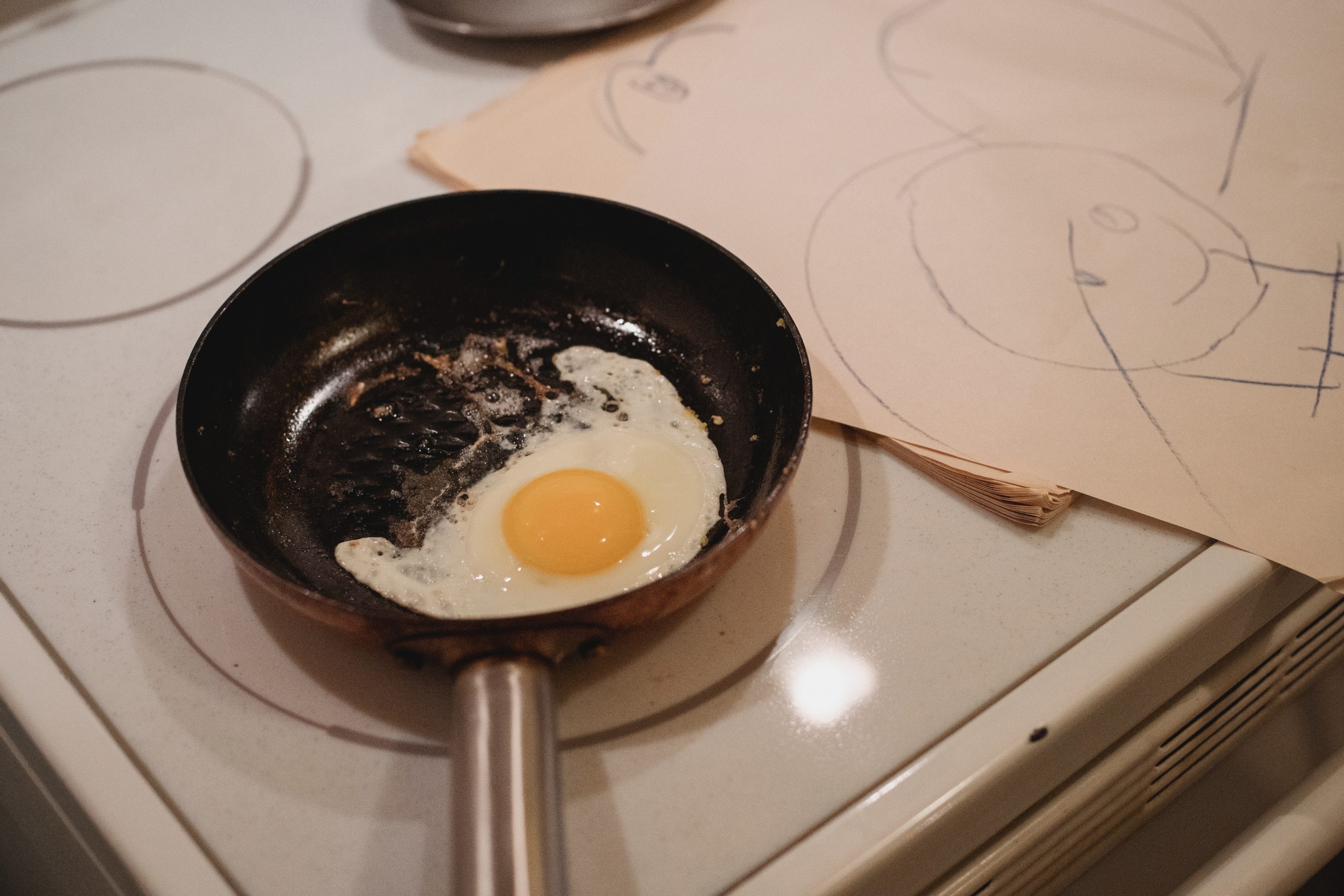A fried egg, also called “sunny-side up,” is a dish made from one or more eggs that have been taken out of their shells and fried in a pan. In many countries, they are usually eaten for breakfast, but they can also be served at other times of the day.
Fried eggs are an important part of traditional German dishes like Strammer Max (the egg is fried on one side with the yolk intact and served “sunny side up” on top of an open ham sandwich) or Hamburger Schnitzel/Holsteiner Schnitzel/Farfahrerschnitzel (a fried egg served on a Wiener Schnitzel). Fried eggs on top of pan-fried potatoes is another common dish, and sometimes spinach is added to the meal as a third party. These are usually served for lunch, not breakfast, though eggs (like boiled or scrambled eggs) are a common breakfast food in Germany.
How to Make Fried Eggs?
Eggs are a versatile protein, paired with a wide variety of flavors and dishes. And there are almost as many methods for cooking and preparing eggs as there are ways to serve them. One popular choice is fried. Fried eggs are cooked in a frying pan, keeping the white and yolk intact. They commonly emerge from the pan with runny yolks and set whites but can be cooked completely, depending on your preference.
Whether you’re frying up eggs as a main dish first thing in the morning or preparing one to top a rice bowl or piece of toast, our guide will walk you through the ins and outs of fried eggs.
So, here are my best tips for making perfectly fried eggs:
Use a Nonstick Skillet:
You could make fried eggs in a pan made of stainless steel or something else that doesn’t stick. But if you use a nonstick pan, it will be much easier to get the eggs out. My favorite pan is one made of cast iron.
Gently Pour in the Egg:
Like in our guide to poaching an egg, I think it’s best to break the egg into a small bowl and then pour it into the pan. (Here’s a pro tip for food styling: if you want the egg to stay mostly together and not spread out all over the pan, hold the bowl about 1 cm away as you pour the egg in. And pour slowly, giving the whites a second or two to find their place before letting the yolk fall into the middle of the pan. Works every time for me!) You can break the egg and pour it straight into the pan, but then it might spread out a lot more.
Experiment and Find What’s Best for you:
When cooking fried eggs, everyone seems to have different ideas about the temperature, how long to cook the eggs, and whether to use butter or oil. The method below is my favorite, but I know many people who swear by a lower or higher temperature or wouldn’t use anything but butter.
Ingredients
- 1–3 eggs
- Two teaspoons of butter or oil
Instructions
- Break an egg into a small bowl with care. (Repeat later if you want to cook more than one egg.)
- Over medium heat, heat the oil in a large sauté pan that doesn’t stick, if possible. Once the pan is hot enough, carefully pour the egg and let it cook until the whites are set, but the yolks are still soft.
- Remove the eggs right away and serve them sunny-side-up.
- Or, flip the egg over and cook for another 10–30 seconds for over-easy eggs, 30–60 seconds for over-medium eggs, or 1–2 minutes for over-hard eggs.
- Take it out and serve it right away. If you want, you can season it with salt and pepper.
Fried Egg Basics
One of the quickest and easiest ways to cook an egg is in a pan, but these simple tips will help you get it right:
1. Use Fresh Eggs
While older (but not spoiled) eggs are best for hard or soft boiling, fresh eggs are best for frying. The egg whites stay solid and together, so they don’t run as much and cook up nicely and neatly.
2. Break the Egg into a Bowl
If you don’t want eggshell pieces in your egg or to break the yolk too soon, crack the egg into a small bowl. If something goes wrong, you can carefully remove the piece of shell or, if the yolk breaks, save the egg for scrambling or baking and start over.
3. Use Low Heat
Unless you want the egg whites to be very crispy, you should use medium or lower heat, letting the egg white set up completely without getting too hard or overcooked.
4. Don’t Over-Crowd the Pan
In a big pan, you can fry up to four eggs at once, but leaving a lot of space is best. This will help the eggs cook evenly and keep the whites from mixing in the pan.
What is the Best Oil for Frying Eggs?
First, decide what kind of fat you will use to fry the eggs. Since fried eggs are usually cooked at a low temperature, fat can be used. Butter and olive oil are often used because they have a lot of flavors. Canola, grapeseed, peanut, and bacon fat all work well. Keep in mind that the taste will change depending on the oil you use. If you don’t want to add any flavor, use a neutral oil like vegetable or canola.
What are the Tools for Frying Eggs?
When you want to fry an egg, you’ll need two main tools: a skillet and a spatula. If you only want to fry one egg, you can use a pan that is eight, ten, or twelve inches wide. Most of the time, you can only fit two eggs into an 8-inch pan and size up to 10 or 12 inches if you want to fry more than one or two eggs at a time.
Even though a nonstick pan is a good safety net, you can fry eggs in any pan. Nonstick is the best choice because you can use less oil, and the bottoms won’t stick, which could cause you to pierce the egg yolk when you take it out of the pan. This includes cast iron, which has a built-in nonstick coating if it has been used for a long time. If you want to use a pan made of stainless steel or something similar, add more fat to keep the eggs from sticking.
When frying eggs, the best tool is a very thin metal spatula that you can get under the egg without moving the soft yolk or tearing the soft white. In a pinch, you can use a thin but strong plastic spatula.
What are the Types of Fried Eggs?
If you’ve ever been to a diner, you know that you can order fried eggs in many different ways. Here’s a quick explanation of the different names and how to make the different kinds of fried eggs.
1. Sunny-Side Up
The whole yolk shows on the top when an egg is cooked sunny-side up. Most of the time, the whites are just done while the yolk is still nice and runny. When most people think of a fried egg, this comes to mind. You can make an egg sunny-side up by basting it or covering it, but don’t put water in the pan; this will make a film on top of the beautiful yolk.
2. Over Easy
For over-easy eggs, the whites are cooked until they are almost set and then carefully turned over. The whites are done, but the yolk is still raw. If you want your fried eggs to be “over easy,” cook them until the whites are opaque but still wiggly and the yolk is just a little bit see-through. Slide a thin spatula under the yolk and flip it over gently. Just a few seconds are needed to set the whites. The yolk won’t be liquid if you cook the egg for too long.
3. Over Medium
Over medium eggs are made the same way as over-easy eggs, except that after the flip, they are cooked for a little longer. This means that the yolk will be about halfway done. It will be mostly set, but it will still be soft and not completely clear. Check on your egg often, lifting it carefully with a spatula, and take it out of the pan when it’s done to your liking.
4. Over Hard
When making over-hard eggs, you fry them, flip them, and then cook them until the egg yolks are fully cooked or “hard.” Still, you should check your egg often to make sure you don’t overcook it. If you do, the egg whites will be tough. When the yolk is done, take it out of the pan and eat it.
5. Crispy Edges
Some people don’t like it when the edges of fried eggs are crispy. They say that eggs should never be crispy. If you like your egg whites a little crunchy, turn up the heat. Since more oil is used in the basting method, it works especially well. Add a couple of tablespoons of oil to the pan and heat it over medium-high heat. Add the egg when the pan is hot but not smoking. Once the bottom of the whites has set, start spooning the oil on top. Because of the higher heat and extra oil, the edges will get crisp before the yolk is done.
Are Eggs Vegetarian?
Even though eggs are not dead animals, there is debate about whether vegetarians should avoid eating foods that require killing animals, even if they don’t eat animal flesh. For example, caviar eggs are taken from inside fish by cutting their stomachs open and taking the eggs out. Even though the eggs themselves are vegetarian, an animal must die for them to be made.
Do chickens have to die for eggs to be laid? No, actually, not really. But, in reality, they do. Unless you buy eggs from your next-door neighbor and have seen how their farm is run, you support factory farming, which kills millions of chickens yearly to get their eggs.
If this worries you, you might want to give up milk, cheese, other dairy products, and eggs. Don’t worry, though. There are many ways to cook and bake without eggs, and one of the easiest is to buy an egg replacer. And, of course, there are plenty of vegan alternatives to milk and dairy that you can use. There are even vegan alternatives to Easter eggs that can be colored.
Conclusion
Many vegetarians eat eggs, even though they don’t eat chicken, cows, pigeons or other animals. You are called an “ovo-vegetarian,” which means” you are a vegetarain who eats eggs. Note that even though eggs are vegetarian, they are in no way, shape, or form vegan.

